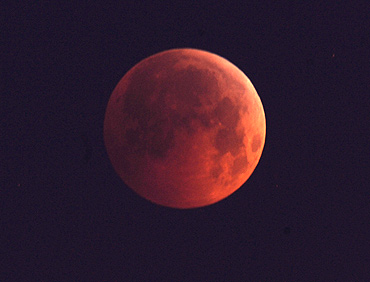
After a wait of 372 years, sky gazers were in for a special celestial treat when the winter solstice coincided with total lunar eclipse on Tuesday.
The last time the two astronomical events coincided was on December 21, 1638.

The eclipse could not be seen in India as it occurred during day time, but astro-lovers could see the full moon turning into a delightful shade of coppery-red from Europe, west Africa, the Americas, the Pacific Ocean, eastern Australia, the Philippines and eastern and northern Asia.

Tuesday was the shortest day of the year as people living on the northern side of the equator celebrated winter solstice.
"It is a day when the Earth's axis tilts the farthest from the sun and is called winter solstice, a term derived from Latin words 'sol' (sun) and 'sistere' (to stand still)," Science Popularisation Association of Communicators and Educators President C B Devgun said.

A solstice is an astronomical event which happens twice each year, when the tilt of the Earth's axis is most inclined toward or away from the sun, causing the sun's apparent position in the sky to reach its northernmost or southernmost extreme, he said.

On the day of winter solstice, North Pole points directly away from the sun and South Pole points directly towards the Sun, he said, adding that the sun shines at lowest heights in northern skies and at maximum heights in southern skies.

This results in the shortest day in the Northern Hemisphere, but at the same time it is the longest day in Southern Hemisphere.
The next lunar eclipse will be seen on June 15, 2011, which will be visible from India, he said. The two events will coincide next time on December 21, 2094.